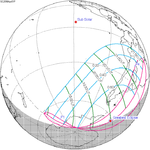Solar_eclipse_of_September_25,_2098
Solar eclipse of September 25, 2098
Future partial solar eclipse
A partial solar eclipse will occur on Thursday, September 25, 2098. A solar eclipse occurs when the Moon passes between Earth and the Sun, thereby totally or partly obscuring the image of the Sun for a viewer on Earth. A partial solar eclipse occurs in the polar regions of the Earth when the center of the Moon's shadow misses the Earth.















